CONTENT
SANRIKU INTERNATIONAL ARTS FESTIVAL MODEL TOUR REPORT
- 2022
- suggested-route
- Interact
- Experience
- Appreciation
Day 2: Saturday, September 10th
A Long-awaited Geinoh Exchange among Young Dancers during the COVID-19 Pandemic
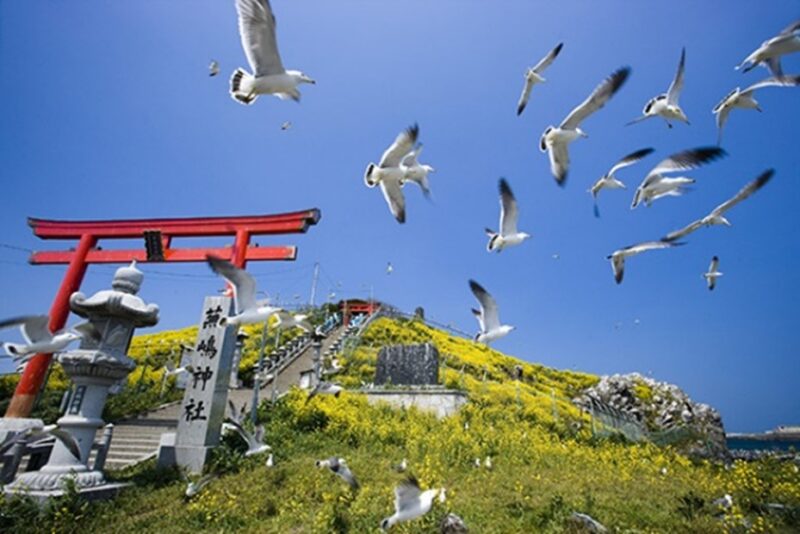
On the second day in the morning, we visited Kabushima Kaihin Park, twenty minutes away from Hachinohe station by train. We recommend that you come here before the sun gets too high. Walking along the shore, you see people such as fishermen carrying kombu seaweed in baskets on their shoulders, and families walking their dogs. Along the way where the sandy beach is interrupted, you see a peninsula-shaped area, Kabushima. The contrasting colors of blue sky and sea, the green island, and the red Torii of Kabushima Shrine at the top of the island are quite striking. This shrine is dedicated to Benzaiten, a deity of wealth, arts, and learning, worshiped for centuries by people wishing for safety while at sea and business prosperity. Kabushima, also designated as a National Natural Monument for its breeding ground for black-tailed gulls, has approximately 30,000 gulls breeding from April to the end of July. During this period, visitors may occasionally be splattered by gull droppings. When visiting Kabushima Shrine, you can borrow an umbrella to protect yourself.
Located nearby is the Marient: Hachinohe City Marine Science Museum, where visitors can enjoy learning about Hachinohe’s fisheries. The aquarium has fish and turtles swimming in tanks. Visitors can even experience a doctor/nibble fish (or Garra rufa) treatment. In addition, there are exhibits of research data from the world-renowned deep-sea exploration vessel Chikyu (Earth), making it a must-see attraction for both adults and children.
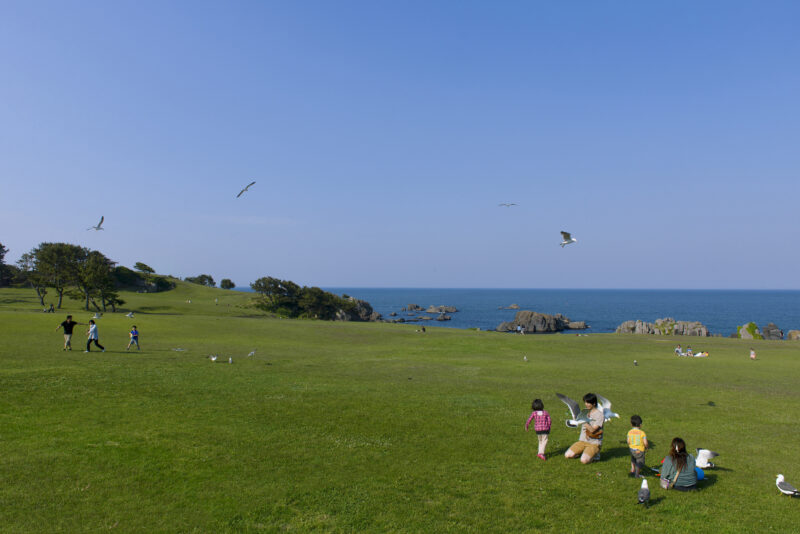
Another recommended activity is the trekking program “Let’s walk along the Tanesashi Coast with a guide!” which starts from the Tanesashi Coast Information Center. Walking in the coastal area for about 2 hours with a local guide, visitors can discover new charms of the Tanesashi Coast. Listening to stories from local people makes the scenery even more vivid, adding to the joy of the experience.
About 1 hour by train or 40 minutes by car from Hachinohe, you enter Hirono Town, Iwate Prefecture. Here, the Dancing Through Hirono: Sanriku Future Geinoh Festival and Geinoh Meeting were held as the main events of the Sanriku International Arts Festival 2022.
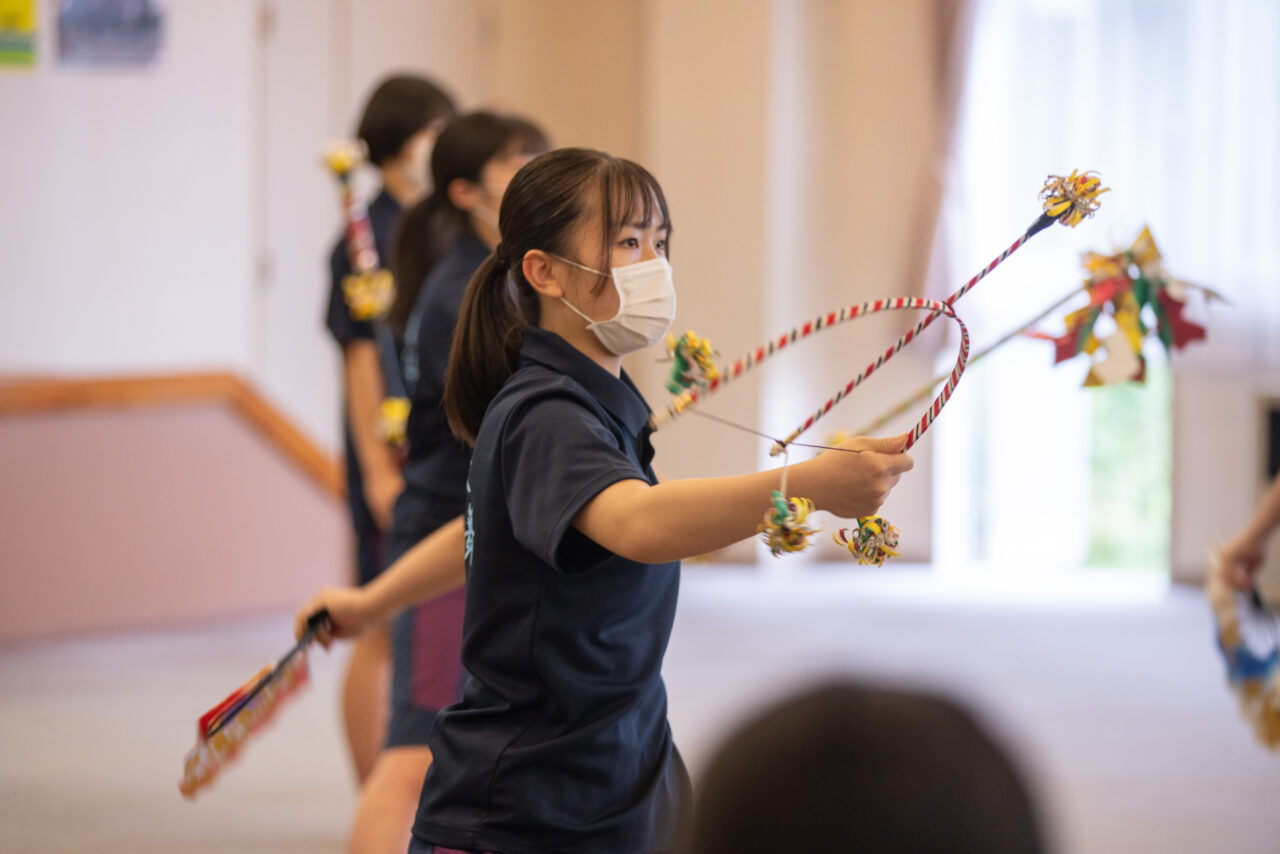
Prior to the meeting, a networking event was held. It was named the Hirono Town Mirai Koryu (Networking for Future) Tour because young local folk performing arts practitioners were invited to participate. Students from two high schools in Iwate Prefecture toured around and gave performances in Hirono Town. The participants included 19 members of the Iwate Prefectural Iwaizumi High School Folk Performing Arts Club and 17 members of the Iwate Prefectural Kitakami Shonan High School Onikenbai Club. Both groups are top-level high school students in Japan, having been awarded the Excellence Prize as representatives of Iwate Prefecture at the 46th All Japan High School Cultural Festival Tokyo Competition: Folk Performing Arts Division held in Tokyo in August 2022. In addition, members of the local Nakano Fuji no Kai who perform the traditional Bon dance called Nanyadoyara in the Tohoku region joined the event. The three groups first introduced themselves and performed their respective dances, followed by explanations of the props and brief lectures on their dances. Although they did not wear the traditional costumes, the ground shook with the sounds of drums and stomping feet, and everyone got excited. The high school students were delighted to have the opportunity to interact with their peers from other regions and experience different folk performing arts, saying, “We are so happy to have this opportunity to be with other dancers our same age. We rarely got to meet with others during the pandemic,” and “This is the first time we have gotten to experience other folk performing arts.”
After the demonstration of their folk performing arts, we boarded a bus and headed to the Taneichi Kaihin Park. Here we visited the Hirono SuisankaikanUNIQUE, a fishery center which is considered a symbol of the Town’s recovery. The exterior is designed to look like a white passenger ship sailing out to the sea. Inside the building, the first thing that catches the eye is uni (sea urchin). It is a direct sales space for fresh seafood caught in the town. We saw a group of sea urchins eating sea squirt or sea pineapple. In the summer, we were told you can try breaking open sea urchin shells. In addition, there is a snack corner where you can taste small dishes made with local food ingredients, and an observation deck, from which you can enjoy a panoramic view of the Pacific Ocean.
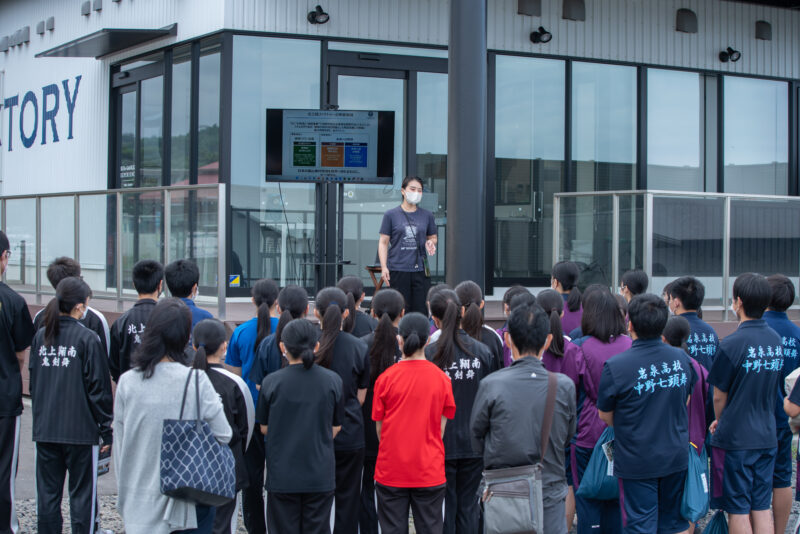
Across from UNIQUE is the Kita-Sanriku Factory, a company that promotes food items from the Kita-Sanriku region, including sea urchins. The white building is adorned with navy blue decorations, including a fish-shaped weather vane, and the words “KITA-SANRIKU FACTORY” in large letters. At first glance, it looked like a stylish sundries shop. There, Mikiko Makka, the president of the company, explained that after the earthquake, the company established the Kita-Sanriku Factory brand in order to promote various initiatives, such as sea urchin farming, development of packaged food, and eye-catching public relations campaigns, that will make the local young people think of their town as attractive. Ms. Makka, herself someone who returned to the region after living in a bigger city, said passionately, “There is so much potential in the region, but information has not been disseminated well and its attractiveness has not been communicated well. If young people can learn more about local industries and find places to be active, that would be wonderful.” Shutaro Koiwa, one of the directors of the Sanriku International Arts Festival and executive director of the Japan Folk Performing Arts Association, who produced the event program, hopes that listening to local companies will provide a seed for young performers to rethink the relationship between folk performing arts and occupations, and the future of their local communities. The young performers we saw must have reflected on their own local communities for themselves because they are involved in folk performing arts rooted in the region.
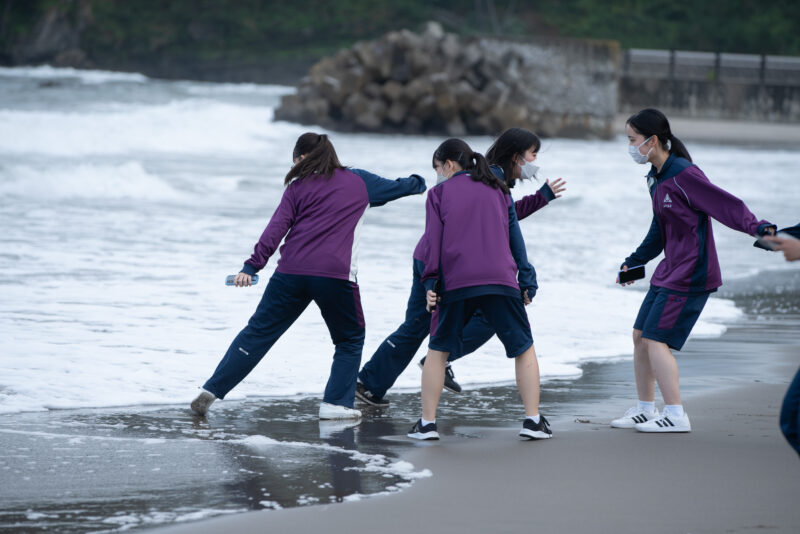
Next to the Kita-Sanriku Factory building is a facility that raises young sea urchins and a natural sandy beach along the coastline. At first, the students were hesitant as if they were afraid of walking on the sand, but gradually they started running towards the waves with abandon. Some students went barefoot, crazily shouting “It’s the sea!” No wonder they were so excited as both high schools are located inland in Iwate Prefecture, and with the impact of the COVID-19 pandemic, some of them had not ever been to the sea even once. After having fun on the beach for a while, they sat down by the seaside and listened to a presentation by high school students from Hirono Town on the problem of marine debris. Students from other areas learned about the environment and the nature of Hirono Town through the words of their peers, saying things like, “I didn’t know there was such a problem with the ocean,” and “It’s amazing that high school students just like us are working on the issue of marine debris.”
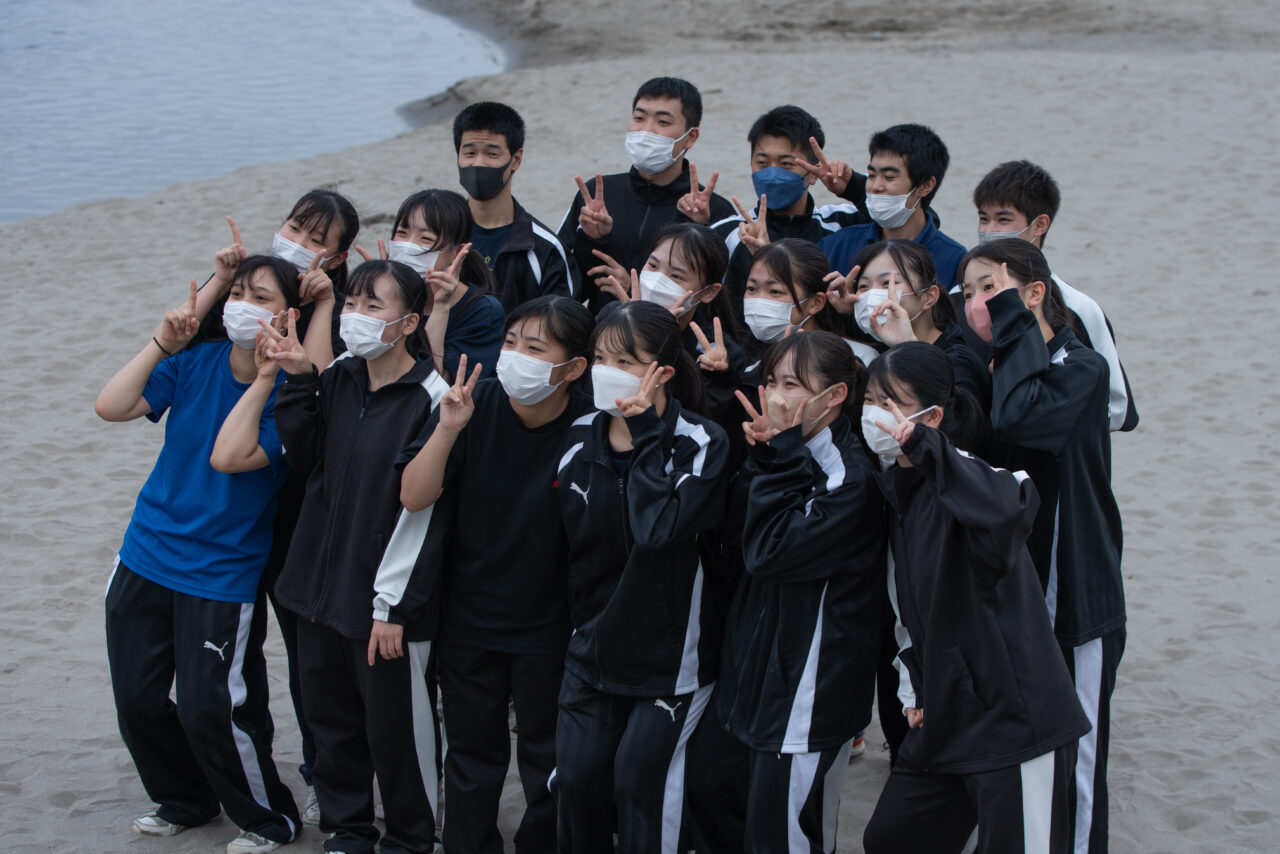
Hirono Town Mirai Koryu (Networking for Future) Tour
Date: Saturday, September 10, 2022, 13:00-15:30
Venue: Nakano Gyoson (Fishing Village) Center, Kita-Sanriku Factory (Hirono Town, Iwate Prefecture)
This networking tour designed for young people features a visit to Hirono Town known for its leading initiatives in recovery from the Great East Japan Earthquake. Participants heard from senior entrepreneurs who had launched successful businesses at the local Kita-Sanriku Factory, learning about what inspired them to work in their hometown, their passion for the community, and their advanced initiatives to share their experiences with the world. In addition, the tour offered lectures and interactive learning sessions with participating folk performing arts groups to deepen mutual understanding of each other’s art forms while building connections. This program was implemented with the goal of providing an opportunity for the young people who will lead the next generation to renew their love for their hometowns, regions and folk performing arts by actually walking through the area and engaging in direct conversations with the locals. Through this process, they were able to gain a renewed outlook on the future.
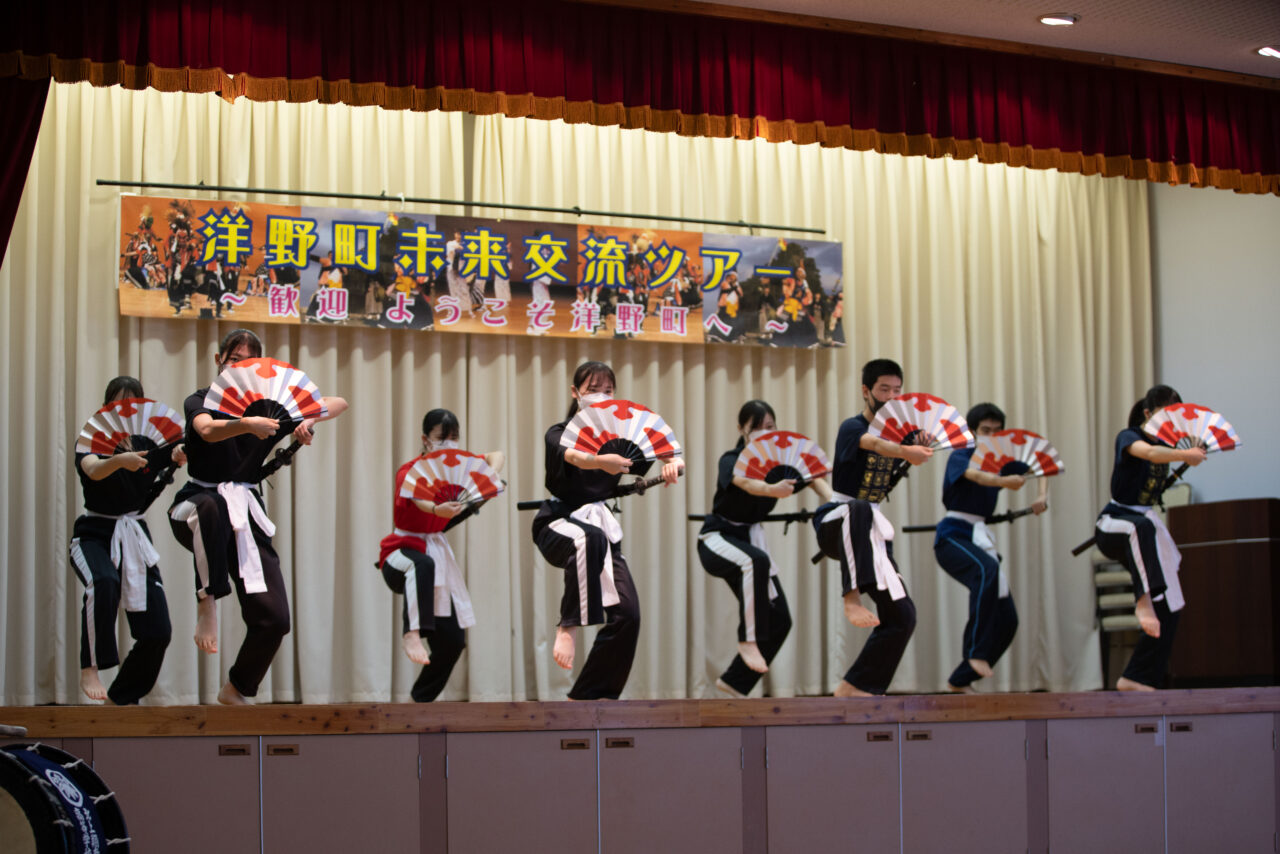
The Future of Geinoh is with the Community
The Geinoh Meeting was held at the Hirono Chomin Bunka Kaikan Cecilia Hall (Community Hall) at 4 pm and was open to the public. The participants included those who were engaged in their local communities, traditions, and folk performing arts, such as young people active in the arts in Hirono Town, students from two high schools in Iwate Prefecture, professional artists, as well as community development coordinators. Members of the general public also joined a discussion about the future of the folk performing arts and their appeal.
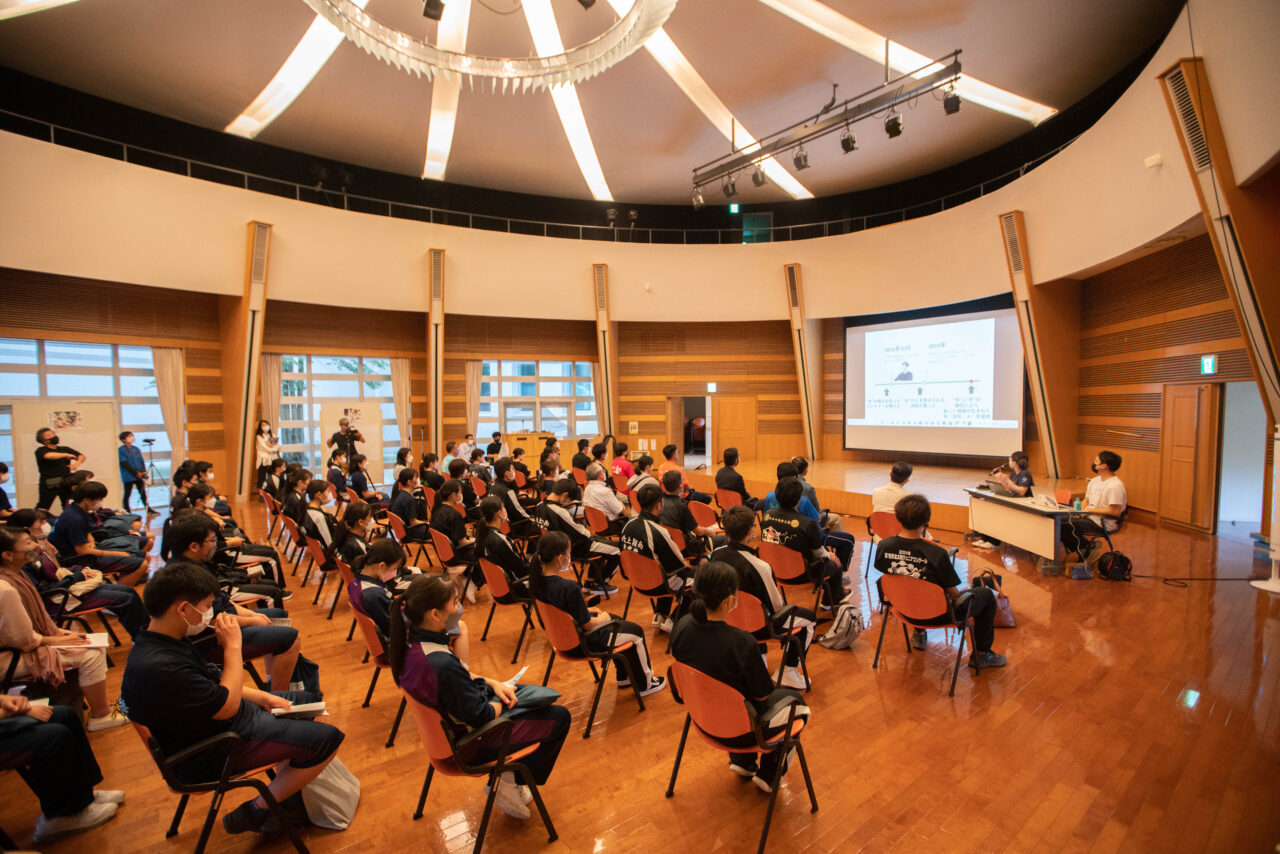
The meeting opened with a lecture on local folk performing arts by Mr. Koiwa. Challenges to the continuation of folk performing arts are a particularly pressing issue faced by many organizations across the country. A shortage of successors, aging instructors, a decrease in performance opportunities, and lack of funding are all critical problems. The Geinoh Meeting was a place where speakers from different backgrounds presented examples and action plans to address these challenges.
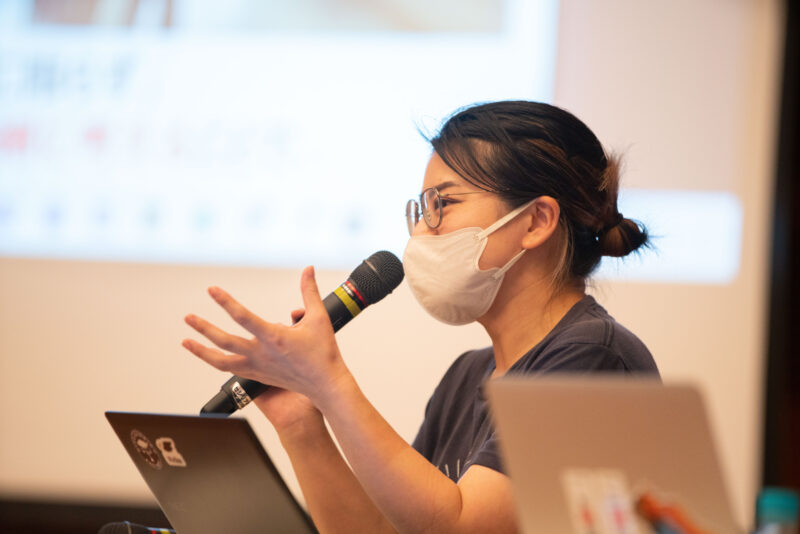
Ms. Makka from Kita-Sanriku Factory, who spoke to the high school students at the beach earlier in the day, gave a lecture on the utilization and revitalization of local resources of Hirono Town. She presented examples such as the Town’s new exchange hub Nigiwai Sozo Koryu Shisetsu HIRONOTTO, a facility opened in 2021 with the aim of revitalizing the community. This facility, created by renovating a closed junior high school, is used to promote tourism and increase the Town’s population. It is now used as an event venue and lodging accommodations. She also talked about the Local Vitalization Cooperator, which has a significant meaning for her. Ms. Makka originally came from Hirono Town, and she came back to her hometown after living in Tokyo for several years. With both insider and outsider’s perspectives, she has been promoting the Kita-Sanriku region including Hirono Town. She has worked with Hirono Town’s Local Vitalization Cooperator to create a system for welcoming people from outside the region and launched other initiatives that generated new revenue for the Town. In addition, since 2014, Hirono Town has been promoting the participation of people from different generations in building the community. As part of this effort, Ms. Makka focuses on fostering young talent through projects with local high school students. Since returning to Hirono Town, she has been responding to the Town’s challenges, such as declining population and the need to cultivate resources that provide income for the region. All of these efforts are linked to the future of the local folk performing arts. Her point of view struck a chord, that we must explore the resources and possibilities of tourism and local economic development in order to think about the future of folk performing arts.
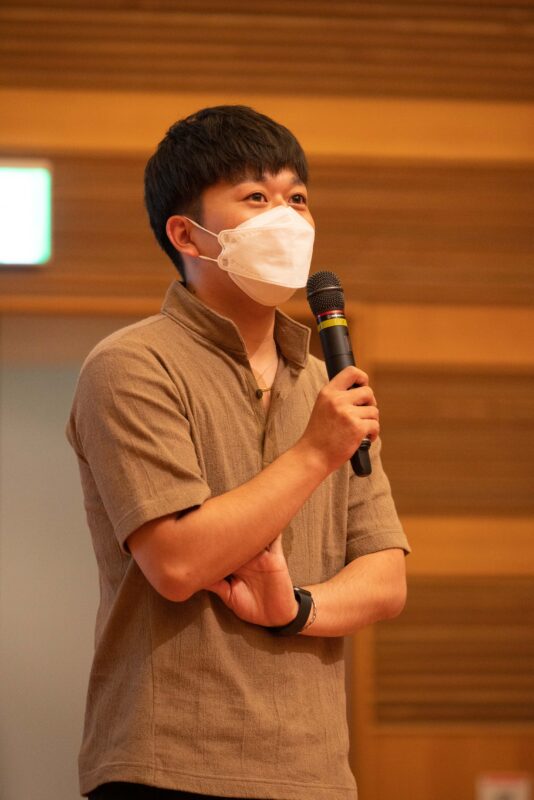
Some guest artists of the World Taiko Conference (WTC) also took the stage to offer greetings. The WTC is an event that started overseas to bring taiko drum enthusiasts together. Creative taiko performances, which originated in Japan about 70 years ago, have become popular around the world. Two members who are involved in this art form shared the background of their activities, which differ from traditional folk performing arts that are rooted in the local community, but still draw on Japan’s traditional cultural heritage. Mr. Masayoshi Ozaki has been active as a taiko player while also working as a high school teacher in Osaka. Mr. Masaya Koike encountered taiko in elementary school and has been performing around the world since he was 20 years old as a member of Kodo, a taiko performing group from Sadogashima Island. What sort of impression did these two performers make on the high school students who are about to graduate and whose relationship with local folk performing arts will inevitably evolve? Hopefully these experiences can provide them with guidance as they consider options and possibilities for their future with the local folk performing arts.
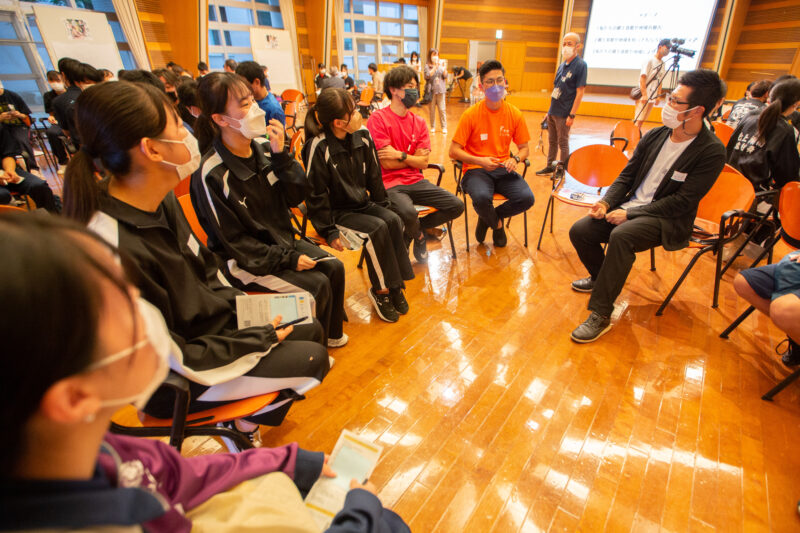
In the latter half of the meeting, all attendees participated in a Local Folk Performing Arts Workshop. The group divided into five teams of about seven people each to brainstorm ideas on three topics: (1) the appeal of their local folk performing arts and regions, (2) how to make them better known, and (3) their hopes and the future. Since people of various generations were present, ranging from high school students involved in different folk performing arts to those in their 70s, it was exciting to see what kinds of opinions would be shared. Regarding the appeal of local folk performing arts and regions, we heard from each person a small part of the reason why they were involved in local folk performing arts, such as, “Because of the relationship between the region and the folk performing arts,” “Everyone can get excited together,” “It becomes a place where different generations continue to come together,” and “It’s wonderful to feel that people support us.” As for how to disseminate their appeal and ideas for the future, the overwhelming majority of young people said “Through social media and online distributions,” while others hoped for more opportunities to “Perform in educational events held outside of the local community or visit and perform at nursing homes,” and “Participate actively in festivals or events outside our local area.” We also heard, “Have children experience the art forms so that they pick it up naturally and want to continue,” and “Become a figure that children look up to.” In fact, some of the high school students who shared stories of how they became interested in local folk performing arts said it was because they were surrounded by them since they were little, or they were drawn to it because they thought it looked cool.
During the brainstorming session, the topics that got everyone excited were comparisons between each other’s folk performing arts and discussions as to whether there were two types of dances: “presentational dances” and “participatory dances.” Looking back at the demonstrations from each group during the networking meeting held the day before, the dancing of Iwaizumi High School and Kitakami Shonan High School was more focused on stage performance than Geinoh’s original purpose. On the other hand, Nakano Fuji no Kai from Hirono Town performed a Bon dance in which everyone, young and old, local residents and passersby, danced together in a circle.
By interacting across groups, high school students were able to gain a broad perspective on the future of local folk performing arts. They recognized the characteristics of their own folk performing arts and the differences from another, and considered how to approach each one depending on the type of folk performing arts and the region. They brought up topics such as “How can we make people want to become performers of the folk performing arts?” and “How can we motivate people to come all the way here and join in the participatory type of folk performing arts?”
Members of a creative taiko drum team from Hirono Town also participated in the workshop. They also found it to be stimulating, saying, “Although creative taiko drumming and local folk performing arts are a little different, we learned by listening to the young people as well as the other groups with different experiences that they have a variety of thoughts and feelings on the folk performing arts. So, we too should bring our thoughts and feelings onto the stage when we perform. That’s how folk performing arts could become cool for a lot of people.” By listening to the adults who had returned to their hometowns and became involved in local folk performing arts, high school students were able to see the problem with inheriting traditions when many young people leave their hometowns for education and employment. They seemed to have been shown a new future, saying, “I felt grateful and happy to have folk performing arts in our hometown, and I realized that keeping the tradition and passing it on to the next generation is important.” It was a fruitful time of exchanging opinions that were coming from the point of view of each of the folk performing arts.
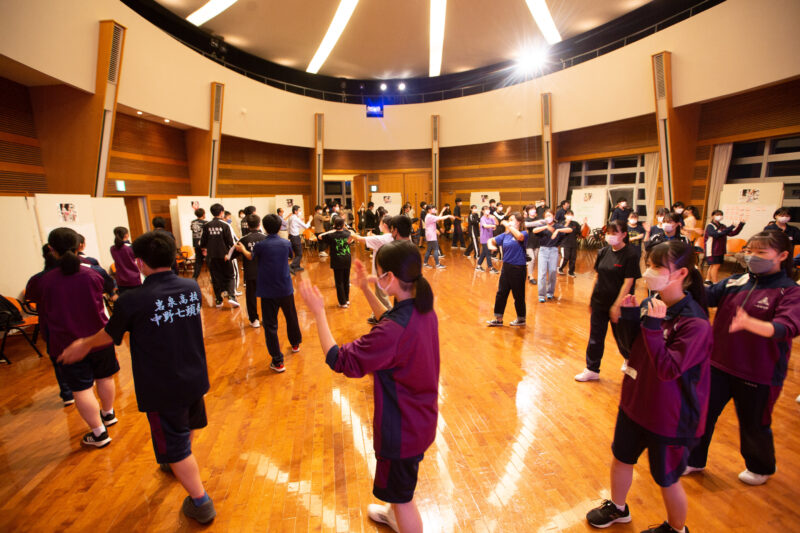
Finally, a workshop was held to experience Nanyadoyara, the Bon dance by Nakano Fuji no Kai, in which everyone dances together. It seemed easy with its simple phrases and choreography, but some dancers were confused saying, “It’s completely different from my dance!” or “I keep getting my feet mixed up!” Nonetheless, they seemed to enjoy it. Gradually, they learned the moves and began to blend in with the people of Hirono Town, who were familiar with this dance. In the end, everyone was wrapped up in the sound of the drums and the heat of the moment. This feeling of togetherness is the joy of participating in the folk performing arts. With a smile on everyone’s face, the event of the day came to a close.
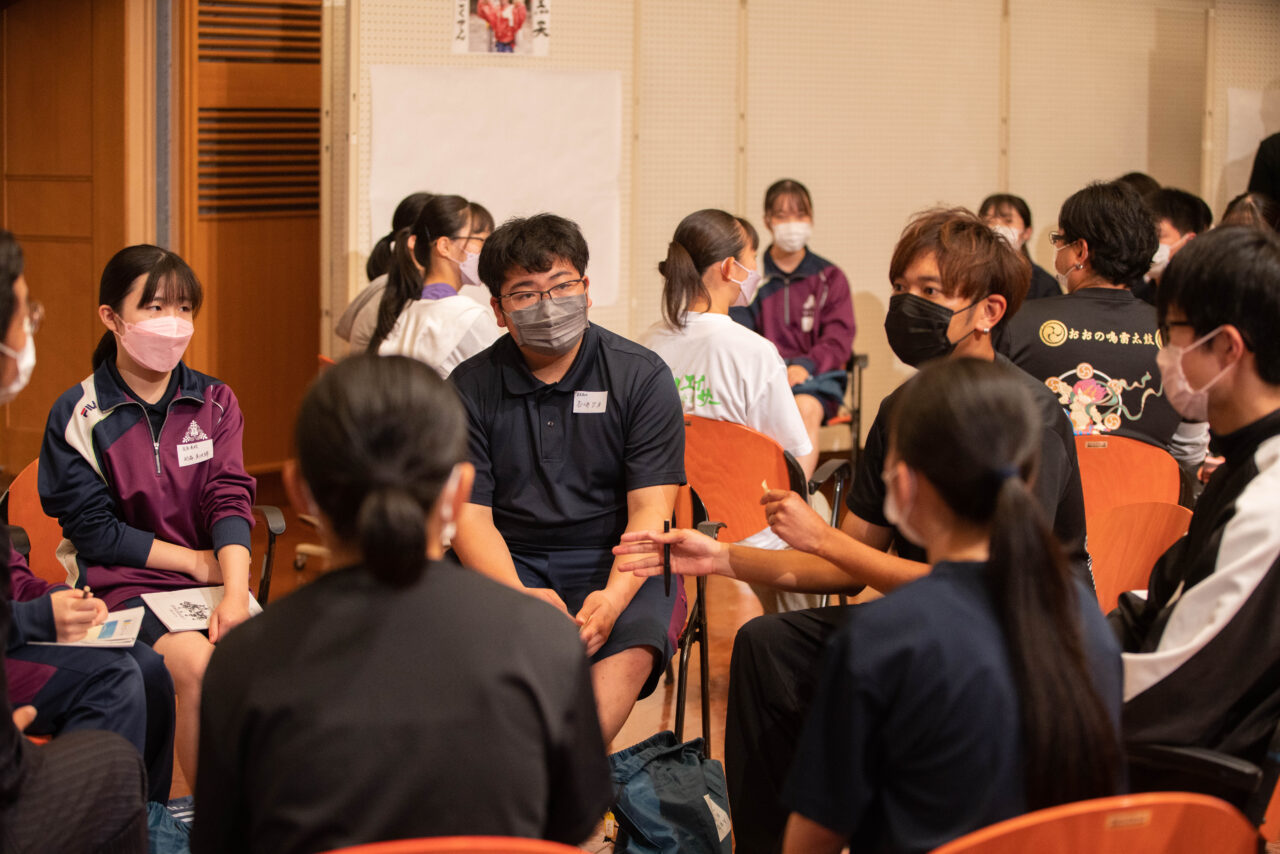
Geinoh Meeting
Date & Time: Saturday, September 10, 2022, 16:00–18:00
Venue: Hirono Chomin Bunka Kaikan Cecilia Hall, Community Hall (Hirono Town, Iwate Prefecture)
The coastal region of Sanriku is said to be a treasure trove of traditional folk performing arts. There are hundreds of different ones that have been handed down in various places, but many of them are facing issues around who will be inheriting the traditions.
To address the issues, a conference was held in Hirono Town. Young folk performing arts practitioners and professional artists gathered together and discussed the significance of the folk performing arts and their future, sharing ideas about all of the creativity and potential that exists in the Sanriku region. At the beginning of the conference local entrepreneurs from the Hirono Town Mirai Koryu (Networking for Future) Tour held prior to this meeting, gave a lecture on examples of utilizing and revitalizing regional resources. After that, about 70 participants, divided into seven groups, discussed topics such as “how to widely promote local folk performing arts and the region” and “the future and hope of the region and folk performing arts.”
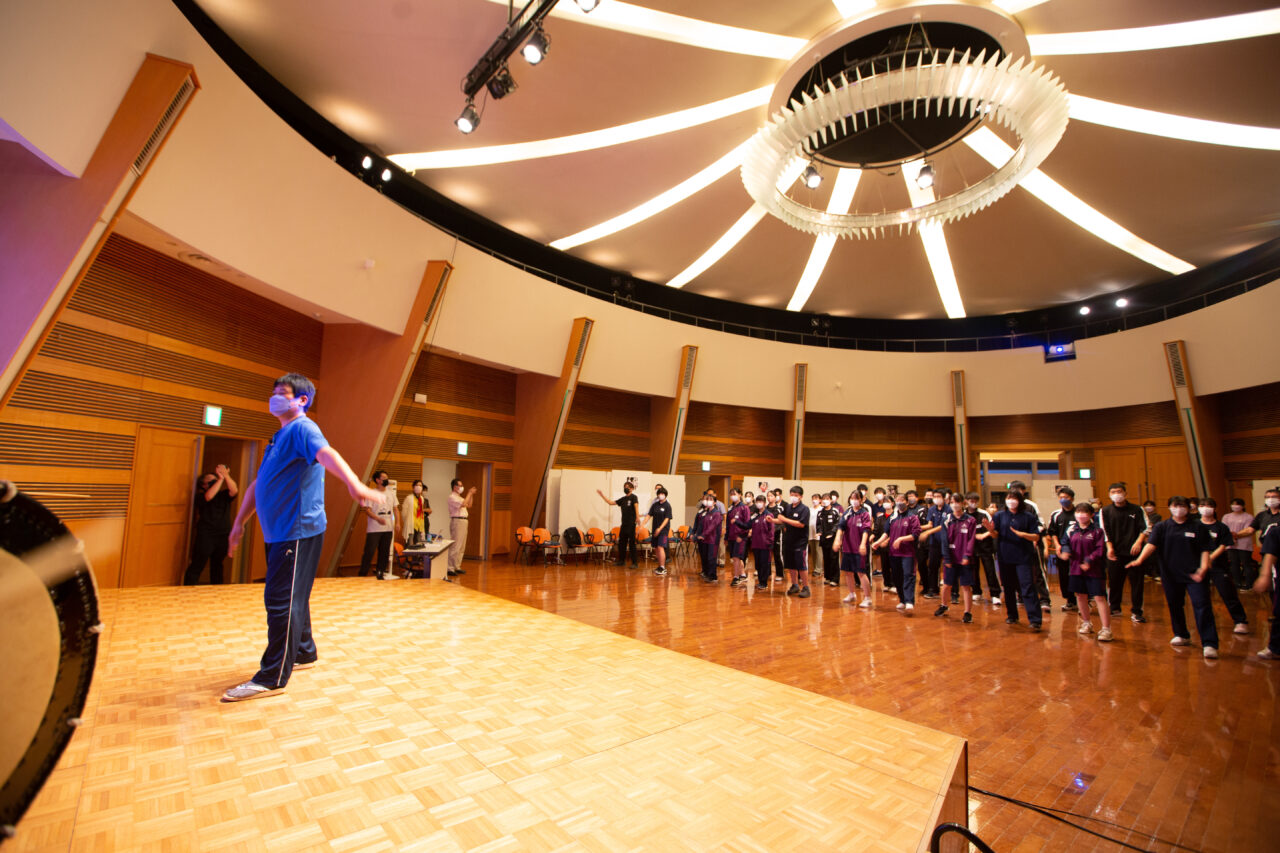
1 Trip to Encounter Rich and Colorful Folk Performing Arts 3 days / 2 nights Sep. 23 – 25 (Fri, holiday – Sun) Route: From Tokyo to Ichinoseki to Ofunato
3Trip to Otsuchi: Meeting the Town of Folk Performing Arts 3 days / 2 nights Oct. 14 – 16 (Fri – Sun) Route: From Tokyo to Morioka to Otsuchi to Morioka to Tokyo